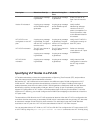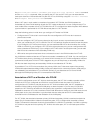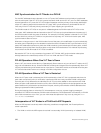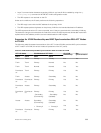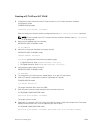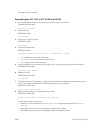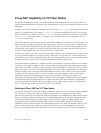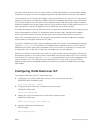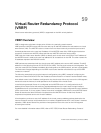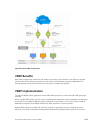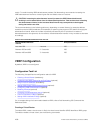Proxy ARP Capability on VLT Peer Nodes
A proxy ARP-enabled device answers the ARP requests that are destined for another host or router. The
local host forwards the traffic to the proxy ARP-enabled device, which in turn transmits the packets to the
destination.
By default, proxy ARP is enabled. To disable proxy ARP, use the no proxy-arp command in the interface
mode. To re-enable proxy ARP, use the ip proxy-arp command in INTERFACE mode. To view if proxy
ARP is enabled on the interface, use the
show config command in INTERFACE mode. If it is not listed in
the show config command output, it is enabled. Only nondefault information is displayed in the show
config
command output.
ARP proxy operation is performed on the VLT peer node IP address when the peer VLT node is down. The
ARP proxy stops working either when the peer routing timer expires or when the peer VLT node goes up.
Layer 3 VLT provides a higher resiliency at the Layer 3 forwarding level. VLT peer routing enables you to
replace VRRP with routed VLT to route the traffic from Layer 2 access nodes. With proxy ARP, hosts can
resolve the MAC address of the VLT node even when VLT node is down.
If the ICL link is down when a VLT node receives an ARP request for the IP address of the VLT peer, owing
to LAG-level hashing algorithm in the top-of-rack (TOR) switch, the incorrect VLT node responds to the
ARP request with the peer MAC address. Proxy ARP is not performed when the ICL link is up and the ARP
request the wrong VLT peer. In this case, ARP requests are tunneled to the VLT peer.
Proxy ARP supported on both VLT interfaces and non-VLT interfaces. Proxy ARP supported on symmetric
VLANs only. Proxy ARP is enabled by default. Routing table must be symmetrically configured to support
proxy ARP. For example, consider a sample topology in which VLAN 100 is configured on two VLT nodes,
node 1 and node 2. ICL link is not configured between the two VLT nodes. Assume that the VLAN 100 IP
address in node 1 is 10.1.1.1/24 and VLAN 100 IP address in node 2 is 20.1.1.2/24. In this case, if the ARP
request for 20.1.1.1 reaches node 1, node 1 will not perform the ARP request for 20.1.1.2. Proxy ARP is
supported only for the IP address belongs to the received interface IP network. Proxy ARP is not
supported if the ARP requested IP address is different from the received interface IP subnet. For example,
if VLAN 100 and 200 are configured on the VLT peers, and if the VLAN 100 IP address is configured as
10.1.1.0/24 and the VLAN 200 IP address is configured as 20.1.1.0/24, the proxy ARP is not performed if
the VLT node receives an ARP request for 20.1.1.0/24 on VLAN 100.
Working of Proxy ARP for VLT Peer Nodes
Proxy ARP is enabled only when peer routing is enabled on both the VLT peers. If peer routing is disabled
on one of the VLT peers, proxy ARP is not performed when the ICL link goes down. Proxy ARP is
performed only when the VLT peer's MAC address is installed in the database. Proxy ARP is stopped when
the VLT peer's MAC address is removed from the ARP database because of the peer routing timer expiry.
The source hardware address in the ARP response contains the VLT peer MAC address. Proxy ARP is
supported for both unicast and broadcast ARP requests. Control packets, other than ARP requests
destined for the VLT peers that reach the undesired and incorrect VLT node, are dropped if the ICL link is
down. Further processing is not done on these control packets. The VLT node does not perform any
action if it receives gratuitous ARP requests for the VLT peer IP address. Proxy ARP is also supported on
Virtual Link Trunking (VLT)
1003




